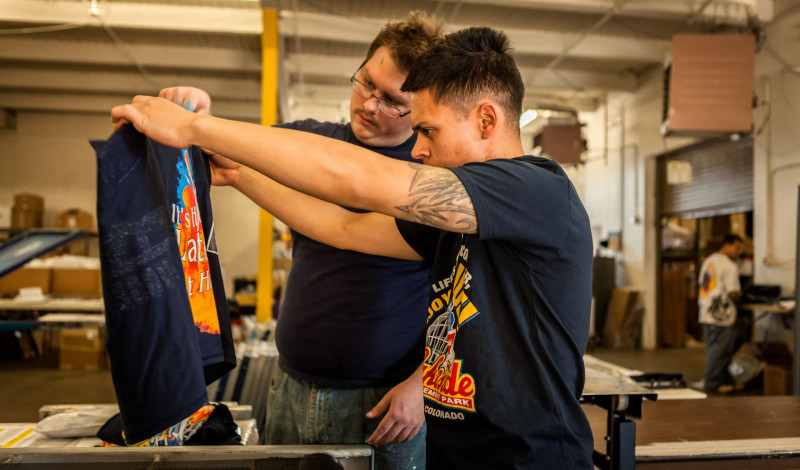Handling a Customer’s Need for Instant Gratification and Small Orders
Instant gratification infiltrates us all. We want the things we want right now. Think about when you got a little annoyed the last time your phone slowly loaded a webpage. Rationally, it’s a silly thing and we just need to be patient, but we have grown accustomed to getting things near instantaneously. This desire for instant fulfillment is everywhere, from Amazon’s Prime shipping to the multiple food delivery apps to choose from for someone to immediately bring you food.
This expectation for instant gratification is moving into all industries, and T-shirt printing is no exception. Successfully handling a customer’s need for instant gratification can be challenging, but there are several actions you can take to alleviate frustrations.
In the age of instant gratification, print shops must be nimble in their offerings
So, what should a garment decorator do? By nature, our products are custom — custom printed with graphics, names, colors, and sizes. The screen printing process takes time, and even well-run shops may need 3 to 5 days to turn around orders.
Handling a customer that wants it “now” can be tricky. Handling the issue properly is vital. Always give realistic expectations and be upfront about your deliverables. Do not give your customer a timeline you know will not be met. It might even help to explain the screen printing process since many people do not know how shirts are printed. Giving them an understanding of the process may help them be more realistic. Let the customer know what your typical turnaround time is and what rush options (if any) are available so they can decide.
Knowing that a larger percentage of customers want quicker turnarounds might mean you should incorporate digital printing into your shop. Having a direct-to-garment (DTG) printer or using the direct-to-film (DTF) process enables quicker turnaround times where you can offer next-day, or even same-day, printed shirts.
If your print shop is set up as a retail or storefront location (you are not solely a contract printer), having DTG would even allow you to lean into a consumer’s desire for instant gratification. Pre-build a dozen or so images that can be easily customized with names or colors so they are readily available to print. Alternatively, you could offer services to print photos from your customer’s phone. Knowing these customers want the shirt quickly lets you build the rapid turnaround time into your pricing structure.
Expertly handling demand for small orders will bring in more business
Causally connected to the need for instant gratification is a growing demand for smaller orders. Customers are pushing back against larger minimums. For example, the local bar and grill used to traditionally order a larger amount of shirts, typically 144, to get a quantity discount. The bar would sit on this printed inventory for a few months until it was sold out before reordering. In today’s environment, this same bar would rather get fewer shirts, maybe 24 to 36, pay a little more, and reorder every few weeks.
Depending on the order details and how your shop is structured, these jobs may be easy or hard to handle. A traditionally set-up screen printing company could easily handle a simple 1- to 3-color design order. The order could be put on-press relatively quickly, especially if it was a reorder and the screens were saved, and the ink costs would be low. This combination of low labor and time investment coupled with low ink costs make screen printing the better choice over DTG printing for this type of small job.
If a small order, or reprint, requires four or more colors, DTG printing is the ideal print method. While DTG ink costs are slightly higher, you will realize big cost savings compared to screen printing. The labor and supplies needed in pre- and post-screen print production are huge.
Production managers allocate an average of 10 minutes per color for registration, so a 5-color job would take 50 minutes. That is a huge labor cost just to print a couple dozen shirts, meaning most traditional screen printing shops would turn down that order. Yet, it is perfect for DTG because there is no set-up time. Plus, you can charge a premium knowing many screen printers would not take such an order.
Incorporating digital printing methods is different for contract screen printers. A contract printer must have an industrial printer, capable of printing 50+ shirts an hour with lower ink costs than “desktop” DTG printers. Even then, most contract printers still use screen printing as their main decorating method with digital printing incorporated in two ways.
The first being offering lower minimums to contract customers. While contract printers might want to stay away from the ultra-small orders, lowering order minimums can bring in new business. Second, any needed reprints can be easily done on the DTG. This would help keep workflow streamlined by not having to setup a job again just to reprint some shirts a customer did not order enough of.
In conclusion, structuring your print shop to handle smaller orders with quicker turnaround might dictate how you handle customers and the technology you invest in. Doing so will better prepare you for the future as customer demand and sentiment continues shifting to wanting things now.

